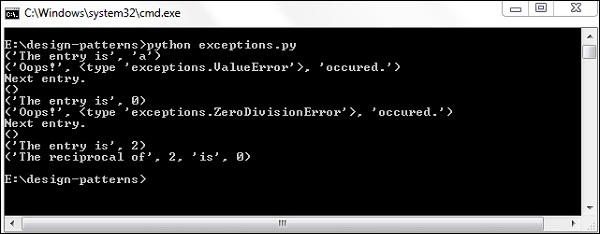
- Python Design Patterns Tutorial
- Python Design Patterns - Home
- Introduction
- Python Design Patterns - Gist
- Model View Controller Pattern
- Python Design Patterns - Singleton
- Python Design Patterns - Factory
- Python Design Patterns - Builder
- Python Design Patterns - Prototype
- Python Design Patterns - Facade
- Python Design Patterns - Command
- Python Design Patterns - Adapter
- Python Design Patterns - Decorator
- Python Design Patterns - Proxy
- Chain of Responsibility Pattern
- Python Design Patterns - Observer
- Python Design Patterns - State
- Python Design Patterns - Strategy
- Python Design Patterns - Template
- Python Design Patterns - Flyweight
- Abstract Factory
- Object Oriented
- Object Oriented Concepts Implementation
- Python Design Patterns - Iterator
- Dictionaries
- Lists Data Structure
- Python Design Patterns - Sets
- Python Design Patterns - Queues
- Strings & Serialization
- Concurrency in Python
- Python Design Patterns - Anti
- Exception Handling
- Python Design Patterns Resources
- Quick Guide
- Python Design Patterns - Resources
- Discussions
Python Design Patterns - Exception Handling
Handling exceptions is also a primary criterion of design patterns. An exception is an error that happens during the execution of a program. When a particular error occurs, it is important to generate an exception. This helps in curbing program crashes.
Why use exceptions?
Exceptions are convenient ways of handling errors and special conditions in a program. When a user thinks that the specified code can produce an error then it is important to use exception handling.
Example – Division by zero
import sys
randomList = ['a', 0, 2]
for entry in randomList:
try:
print("The entry is", entry)
r = 1/int(entry)
break
except:
print("Oops!",sys.exc_info()[0],"occured.")
print("Next entry.")
print()
print("The reciprocal of",entry,"is",r)
Output
The above program generates the following output −

Raising Exceptions
In Python programming specifically, exceptions are raised when corresponding error of code occurs at run time. This can be forcefully raised using the “raise” keyword.
Syntax
raise KeyboardInterrupt Traceback (most recent call last): ... KeyboardInterrupt
Advertisements